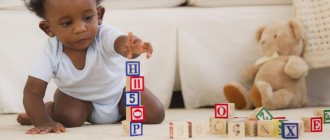Parents want to give their baby everything he needs from birth, monitor his health and psychological state, and strive to teach the child to speak on time and correctly. Speaking cannot be taught separately from the development of other processes. When mastering speech, the psychological state of the baby plays an important role. Parents need to develop their baby’s memory, thinking, imagination, and attention from birth. A newborn baby is already ready to perceive the world, to cognize it in order to develop further speech, as a way of interacting with others and satisfying his own needs.
Tips before starting training
Before we talk about how to teach a one-year-old child to speak, let’s talk about the harmonious stages of speech development in a baby:
- up to three months is the period of pronunciation of the first most convenient sounds such as ghouls;
- from 4 months, sounds become clearer and more articulate;
- from seven months, a child, not yet aware of specific objects, can pronounce short words with repeating sounds - mom, dad, baba;
- from nine months the baby already knows what he is talking about, he pronounces consciously - aw-aw (meeting a dog), kaka, mom, dad;
- by the age of one year, the baby’s vocabulary is up to 10 syllables (let’s not call it words for now) and is replenished with new ones every day;
- from the age of one and a half, the child begins to combine words into simple sentences - baba bye, baka avav, mom kuku, dad dada;
- From the age of two, the child should begin to master the language in its declensions, combine it with prepositions, and arrange sentences in the correct order.
How to teach a child to speak correctly
From a very early age, children need to be taught to speak correctly:
- You need to talk to the baby in the first day of life, it doesn’t matter that he doesn’t understand the meaning, don’t worry, but he learns to hear intonations and passively accumulates a vocabulary of words that will help him start speaking with meaning.
- Use the pacifier as little as possible (or even abandon it altogether). Studies have shown that children accustomed to a pacifier began to speak later than their peers, in addition, their bite was not formed correctly, which can create problems with correct articulation.
- There is no need to lisp, speak correctly right away. Of course, when you see a baby, it is difficult to resist smiling and not making a fuss. But speech therapists know that this inhibits speech development. The child himself can distort words due to inability, even if he says kika to candy, and bubba to grandma, but parents must speak correctly. Do not force a distorted language on your child, he may remember it, but then he will relearn it, this will take time.
- We already know that in the brain there are adjacent centers responsible for finger motor skills and speech (by the way, adults who have suffered a stroke are given children’s motor skills exercises to develop speech). All kinds of finger games are very important, now there are games in which you need to tie something, put a string into holes, in life it’s tying shoelaces, fastening buttons.
- Encourage intellectual curiosity and learning. In addition to developing articulation, teach your baby logic, the relationship of objects, and their descriptions. When a little why torments you with questions, don’t brush it off, but enjoy the fact that you know everything and can tell your child everything he asks about.
- Teach your baby to read. By reading to him, you set an example, and in the future this will make schoolwork easier; in addition, reading introduces new words, develops imagination, and reinforces already known words. Show your child that books can not only be torn, but that they can be looked at, they are interesting. Buy him large colorful books with pictures and short poems, so you also teach him to speak. There are books with three-dimensional figures; you can move them, describe them, talk about them, and even invent stories.
- To begin with, use simple words in your speech when communicating with your child to make it easier for him to remember them. When he learns to operate with them and moves to another level of communication, replenish the baby’s verbal baggage. Don't forget to teach him what new words mean, also in a very simple way.
- Moving on to sentences, conduct a dialogue with your child, ask him more, provoke him to tell stories, describe objects and phenomena.
Massage, games, reading, and gymnastics will help you teach your child to speak.
General principles or how to quickly teach a child to talk
To stimulate development and teach the ward to speak, it makes sense to adhere to a number of rules. They will make the process more efficient. Basically, these rules apply to children from 1.5 to 3 years old. You are unlikely to be able to teach a one-year-old child to speak. Although there are such cases. The described rules are also relevant in later years, up to 7 years. What are these principles?
- Take your time
Speech development largely depends on the individual characteristics of the body and psyche. Therefore, you should not force the process. You won’t be able to force your child to talk; it’s a waste of time. Moreover, it is very harmful: under certain conditions, for example, if such violent attempts are repeated, you will get the opposite result. Conversational speech will not develop, and a psychological block will form. It will no longer be possible to cope with such a situation on your own. No violence, just persistence and perseverance. In the same time…
- We must start from the very birth of the child.
This does not mean that you will have to force your first words. Under no circumstances should you do this. Your task is to constantly talk to each other every day. It’s good if there is someone in the family who can keep you company. From the age of one to 5 years, children quickly learn what they perceive by ear. Therefore, conversations can be considered an exercise option. True, passive, based not on action, but on perception.
- Don't make your child bored
It is best if classes are held in the form of a game. On the one hand, this form of communication eliminates pressure. On the other hand, he himself is interested in what will happen next. Under no circumstances should you scold a child. How this could turn out has already been said above. Conduct classes in a playful way: use toys and visual material. You can show your artistic abilities. The main thing is that the skills are learned easily and naturally. Oddly enough, at the age of 5 and even 7 years, this approach gives the best results.
- Exercises
It is advisable to follow a certain system when planning classes. In addition to “improvisation”, resort to the developments of speech therapy and defectology. Use exercises and their complexes. It makes sense to contact a specialist or at least find such options on your own. The question is left to your discretion.
Variant of exercises for starting speech:
- Develop fine motor skills of your hands
Research shows that the area of the brain responsible for speaking is also responsible for normal speech, its completeness, and expressiveness. Also for the very possibility of speech. A simple conclusion follows from this. It makes sense to develop fine motor skills, then the second, related skill will be formed faster. It is simple and interesting for the student himself.
Construction sets, paints, and pencils are used. Design, draw, etc. These are the main methods. In this case, the cerebral cortex is formed until the age of 20-22. Therefore, the same rules apply to older children.
- read books
Don't leave your children alone with you. This has a bad effect on speech function. Read exciting books. You need to select options according to age. Folk tales are suitable for children under 1 year of age. Further more. You can take fairy tales from peoples of the world, longer works, but so that the ward does not get tired. Otherwise there will be no result. Do not try to get a one-year-old baby to talk in this way. But know that the process is ongoing, there is just no active talk yet. At the same time, the brain actively forms neural connections. Be patient.
- Sing
Singing helps develop the frontal and temporal lobes of the brain. Both of them are responsible for the speech process. Her expression, the richness of her vocabulary. Also for hearing, including musical hearing. It makes sense to develop your singing skills. You don't have to be a professional to follow this principle.
- Don't babysit
Mistakes or simplification of the pronunciation of words at the initial stage of speaking are quite normal. But under no circumstances should you become like children. A person loses the feeling of how to pronounce this or that word correctly. Or even not at all, if lisp is practiced systematically. Your ward can only be taught to speak if you speak correctly yourself. Otherwise, defects and bad habits will arise. They cannot be eliminated without the help of a speech pathologist.
By sticking to the basic principles, you will build a strong foundation. Although outwardly you are unlikely to notice much difference.
Massage
One of the speech correction methods that improves voice, breathing, and normalizes emotions. We will not talk in detail about complex massages practiced by speech therapists for severe cases of speech disorders. They are necessary if it is necessary to teach a child to say the letter P, for stuttering, speech delay, problems with ligaments, decreased and increased muscle tone.
Depending on the problem, speech therapy massage can be activating, relaxing or differentiated. The speech therapist makes a diagnosis, then prescribes a treatment regimen, in difficult cases he works himself, in simple cases he shows the mother what to do.
Relaxing speech therapy massage
The child can lie or sit, whatever is more comfortable for him and depending on the circumstances. The massage is done with light stroking techniques.
To relax the neck muscles
- stroke the neck with both hands from top to bottom;
- carefully turn the baby's head back and forth, left and right, then rotate it clockwise and counterclockwise, holding the neck with one hand and the forehead with the other.
To relax facial muscles
We stroke with the fingers of both hands up to 10 times:
- to the temples from the middle of the forehead;
- from eyebrows to hair;
- circles around the eyes;
- from the bridge of the nose to the temples under the eyes;
- from lips to ears;
- lightly press with your fingers from hair to chin all over your face.
Relaxing the lip muscles
- trace your lips with your fingers;
- stroke from top to bottom along the nasolabial folds;
- tap clockwise around lips.
Revitalizing massage
To activate facial expressions
We stroke with the fingers of both hands up to 10 times:
- to the temples from the middle of the forehead;
- from eyebrows to hair;
- circles around the eyes;
- from the bridge of the nose to the temples under the eyes;
- from lips to ears;
- squeeze your chin;
- stretch your cheekbones and cheeks;
- pinch your cheeks.
To activate the lip muscles
- pinch the skin around the lips;
- tap vigorously around lips.
To activate the muscles of the neck and shoulders
- rub the side surface of the neck from bottom to top to the corners of the lower jaw;
- rub the posterolateral surface of the neck from bottom to top from the shoulder blades to the back of the head;
- ask the child to tilt his head back and forth, left and right, while counteracting these movements with his hand.
Differentiated massage
For mixed disorders, a massage is performed that combines relaxing movements with tonic ones. During such a massage, you need to carefully observe the responses of other muscle groups, so such a massage should only be performed by a specialist.
For children, the massage should be very short, 5-8 minutes, in junior classes – up to 15 minutes, in senior classes – up to 25 minutes. At an early age, massage should not exceed 10 minutes, in junior preschool - 15 minutes, in older preschool and school age - 25 minutes.
The child should be comfortable during the massage. If there is increased sensitivity, leave this exercise and consult a speech therapist.
Usually children quickly adapt to massages and do not experience any negative feelings. If the baby is frightened by these movements, you need to change the techniques to easier and gentle ones or stop altogether for a while.
Exercises for the development of the speech apparatus
When considering how to properly teach a child to speak, it is worth spending time on special exercises. Simple daily exercises will help develop your child's speech skills. It is enough to spend 15-20 minutes a day on exercises . Examples of exercises:
- " Window ". Open your mouth as wide as possible – it’s hot, close your mouth – it’s cold.
- " Brushing our teeth ." The child needs to smile and open his mouth. Use the tip of your tongue to clean the upper teeth, then the lower teeth, from the inside.
- " Knead the dough ." Smile and slap your tongue between your lips “la-la-la-la...”. Bite the tip of your tongue with your teeth. Alternate the two movements regularly.
- " Calyx ". Smile at the child, open his mouth wide, stick out his wide tongue and shape it into a cup. That is, the baby needs to slightly raise the tip of his tongue.
- " Dudochka ". Tense and stretch your lips forward with tension.
- " Fence ". Smile and open your closed lips with tension.
For older children, you can use the following exercises:
- You need to learn to express emotions with sounds : dissatisfied “ah-ah”, delight “wow”.
- We need to sing together and learn how to regulate the pitch of our voices . If the baby imitates well, then call each other with sounds during household chores.
- Pronounce the names of objects . When feeding, talk about spoon, fork, plate. When bathing, talk about water and soap.
There are many exercises that will help develop speech skills. A wide range of benefits is available for this purpose.
Gymnastics for articulation
You don't need a speech therapist here. This gymnastics is needed so that the child can learn to speak correctly. In a game-like way, you train your baby’s speech apparatus and help him master words.
How to perform
Any skill is strengthened with regular and gradual practice. The rules are:
- do no more than 2-3 exercises;
- lesson duration is from 5 to 10 minutes;
- repeat the exercises several times.
You should not work, but play, then the baby will be interested in doing this, since these exercises apply to small children, from one and a half years old, whose speech therapy problems are not yet expressed, but for prevention it is worth doing small simple exercises.
- “We open and close the gates.” Invite your child to open his mouth with you, hold it for a couple of minutes and close it.
- “Show me the fence.” This means clench your teeth and smile hard.
- “Let’s brush and brush our teeth.” Open your mouth with your baby and show him how to brush his teeth with his tongue, running along the inside and outside of them.
- "Artist". This exercise is more difficult. The baby needs to draw any objects on the sky with his tongue. Or you can paint over the entire sky.
Don't be serious, play it together, gymnastics will help you pronounce sounds beautifully from an early age.
Listen child
Very often mothers with children come to me, confident that their babies do not speak. While playing, I sometimes hear not only words, but also sentences!
They just pronounce them indistinctly, omitting letters or even naming objects in their own way.
Photo source: From the heroine’s archive
It is very important to “hear” your child’s speech in time, respond to it and praise for communication. This will help the baby understand that these are not just sounds that escaped him - you understand him.
As already noted, the reaction for the development of speech is largely decisive.
So, at 7 months my daughter confidently said “Bai” to a butterfly, and “Pai” to her fingers. I supported her, plus I repeated the correct names. A month later, she pronounced these words correctly, and they became one of the first in her dictionary.
Simple exercises for children
How to teach little ones to speak
From the very first days, establish contact with your baby. Smile at him, respond to his movements, talk to him, sing, diversify your speech, change your voice, while your speech should be correct and clear. Talk to him constantly, explain where you are going and why, what you will do with him now. Be sure to pause if you see that the child is trying to answer something, albeit in his own, for now bird, language. Ask him questions, even the smallest ones. Is it true? You think so? Is that what you decided? Depending on the circumstances.
Use your grandmother's poem-games: okay, magpie-crow, geese-geese-ga-ga-ga, magpie-white-sided or the horned goat is coming; in addition to memorizing words, such games also develop fine hand coordination. Remember or look for other counting rhymes, washers, spillers, walkers, and so on. Play different games with fingers, list them (at the same time - teach your child to count -), let the baby bend his fingers, this thumb is dad, this thumb is mom. Or, for example, your fingers fell asleep. Bend one finger at a time, and then wake everyone up, let them straighten up with a shout of hurray, wake up.
How to teach a child to speak at 1 year old
When you walk with him around the room, in the kitchen, down the street, tell him about everything that comes your way. It will be a victory if the baby himself starts pointing and trying to name the object, then you can teach him more. Describe his actions. He came up and opened the door, he said - you opened the door, now close it. If he picked up a spoon, say - you have a spoon in your hands, put it down.
Game of questions. Ask questions about everything and answer them. For example: who is this? This is Dad. What is he like? He's big and strong. And who are you? You're a baby. What are you like? You're small. At the same time, you can also show how small and how big, and so on until you get tired of it.
Do regular simple exercises to develop your speech apparatus:
- sing together rhythmically and with any melodies ma-ma-ma;
- moo like a cow, crow like a cockerel, meow like a cat, and so on.
How to teach a child to say mom
Don’t be lazy, use the simplest parental technique with which they pester the child, say mom, say grandma. This method is far from unique and is suitable even for the little ones; it forces the child to repeat after his mother. Here are the methods that will help teach you to speak words meaningfully:
Images. There are many educational books with pictures, they are visually very good. Who is this, point to the cat and answer - cat, she says meow. The baby should begin to understand which animal in the picture refers to which sound. Then continue this game outside, not with pictures, but with live animals.
Use sounds to mark your baby's actions. If he falls, say boom-boom. If he claps his hands, say clap clap. Top top. Chug-chug. At the same time, you will overcome the child’s 1st year crisis.
How to teach a child to speak at 2 years old
Tell your child a rhyme or song so that it is simply remembered and rhythmically reproduced. When the child remembers the poem, he will not be able to repeat it entirely, but provoke him to say the last line himself. To do this, stop at the penultimate line or pronounce it incorrectly.
Start the game by asking your child where this or that object is. Where's the table? Where's the cube? Where is the bear? Let the baby find and show. And then, later, he also calls it.
Edible - inedible. Say different words and if you name something that you can eat, say - um, pretending that you want to eat something. And keep up the good work. You need to ensure that the baby himself begins to tell you when you name something edible.
Come up with games yourself and your baby will also tell you something, you’ll see. Children learn about the world by touching it. Use this principle and play.
Development of speech of preschool children based on the methodology of Ushakova O.S.
The development of human speech is formed in stages. The most important is the preschool age. It is at this time that children are curious and interested in learning everything new. Therefore, it is very important to create maximum comfort, as well as correctly present information so that it can be easily understood by your daughter or son.
For your information. In addition, the formation of speech is influenced by active activities in different sections and kindergarten.
The main goals and objectives of O.S. Ushakova’s methodology.
Ushakova’s method for developing speech has a special task. Therefore, in order for the solution to the problem to be effective, it is first necessary to determine the causes of delayed speech development. The main task in developing correct speech production is the competent choice of teaching techniques aimed at the following points:
- Expanding your vocabulary and the ability to fully use them.
- Improvement and correction of sounds.
- Ability to express yourself clearly and formulate your thoughts.
- Teaching preschoolers to speak correctly.
- Stimulation to clearly pronounce sounds.
- Improving knowledge.
The technique is carried out in stages. The method is based on the assimilation of simple material and techniques, which later become more complex. But tasks need to be made more difficult for the little ones unnoticed. After just a few sessions you will be able to see a positive result.
On a note. It is precisely the tasks that are not very complicated that are well absorbed by children and have a very effective influence on the development of speech in the future.
Preschooler develops speech
Rules for mothers who teach their child to speak
If you are wondering how to quickly teach a child to speak, the answer will be - it is not easy. You will have to work and follow certain rules:
- Patience. All children are unique. If your neighbor's child is doing something your child isn't already doing, don't make a fuss. The child will say everything when he is ready for it. Don’t be angry if your baby can’t say the word mom; statistics show that only 40% of children who say mom as their first word more often say “give.”
- The misconception is that if they don’t speak, it means they don’t understand.
Babies instantly remember everything you say, but they need time to repeat it. This is called a passive vocabulary; the child already has it, but he is in no hurry to voice it. Don't rush him, continue to teach him to speak on any occasion. Remember how grandma did it: Lenusya eats, Lenusya sits - all this adds up to a dictionary in the child’s head, which is activated very soon. - Call everything by its proper name, do not lisp, do not use diminutive forms, otherwise you will confuse the baby. Talk to him normally and he will learn to speak sooner.
- Positive emotions. Doing everything together with mom, playing, walking, exploring the world along the way - the main thing is for the baby to talk to you as soon as possible. Increase his interest in what is happening around him. With positivity, everything happens faster.
- Sing. A mother’s voice is the most pleasant thing for a child. Oddly enough, it has been noticed that if a mother sings often (not just lullabies), mutual communication will not take long to happen.
- Repeat simple phrases. Speak very short phrases every day. Do this often and soon your child will want to repeat it.
- Repeat after the child. Mom is the best friend, and with a friend it doesn’t happen that only he speaks, and the other one repeats after him. Try doing the opposite once a day, the baby speaks, and you repeat after him. And if you imperceptibly replace a sound in a word and get a new word, rest assured - you helped your baby learn a new word.
- Play. Your child wants to play all the time, and it’s no wonder who wants to play in a year or two. So play! Cover your face, ask where mom is, open your face and say mom. And very soon your baby will answer your question.
- Associativity. Speak so that the child understands who you are, who this is, what this is. Talk about yourself in the third person. You say mom has come. Hide the toy and ask - where did mom hide the bear? Very simple exercises will allow the baby to know that you are his mother and soon he will call you himself.
- Support your baby. Even we, adults, need praise, but what can we say about a child? Praise him for every small victory and he will want to do more of the same. Express your emotions openly, applaud your miracle.
- Don't force it. Don't force, don't insist - tell mom. Engage, play, support and love your child, and the result will please you.
Everyone has their own time
It is generally accepted that a child first pronounces the word “mother” at about one to one and a half years.
Of course, a six-month difference is a lot, but each baby has its own, individual development schedule. Therefore, for the time being, parents have nothing to worry about. The little one didn’t say the cherished word at one year old, but he will say it at one year and three months. Or a year and a half. We just need to wait a little. It’s another matter if, even after one and a half years, the child does not try to say anything. In this case, there may be some disturbances in the baby’s development, and therefore you should definitely seek medical advice. If the baby develops somehow incorrectly, the doctor will prescribe treatment.
But if everything is normal with the child’s health, and the baby is delayed in development for natural reasons, mom and dad should help him say the long-awaited word “mom.”
Video
A conversation with a speech therapist about how to teach your child to speak. At the same time, the presenter also gives interesting advice.
There is no need to be shy to play, rejoice, have fun, all this is the key to your future friendship and mutual understanding. And also respect for each other. You will respect your child and he will learn to respect you. He doesn’t know how to speak yet, but he already sees you, feels your emotions, understands your gestures, and this means that he is already a person. He explores the world, and you help him with this. Isn't this wonderful? Share with us, maybe you have some interesting games that you have invented? And it’s also very interesting: when did your baby start talking?
Reviews and comments
You can share your successes in this difficult but very enjoyable task below.
We also recommend that you familiarize yourself with the lessons on rhetoric on our website and the article “Tongue twisters for the development of speech and diction.”
We also recommend reading:
- Storytelling
- Development of fine motor skills in a child
- Development of communication skills in children
- How to teach a child to read quickly and correctly
- Piaget's theory of cognitive development
- How to teach a child to pronounce the sound “R”
- How to teach a child to read
- How to teach a child to read English
- Exercises for memory development in preschoolers
- Children and money, or How to teach a child to manage money
- How to get your child interested in reading?
Key words:1Children










